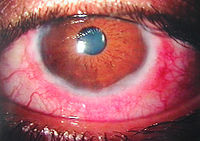
Photo from wikipedia
PURPOSE Severe vernal keratoconjunctivitis (VKC) can cause ocular surface disease including partial or complete limbal stem cell deficiency (LSCD), especially in early-onset and severe limbal form of VKC. We report… Click to show full abstract
PURPOSE Severe vernal keratoconjunctivitis (VKC) can cause ocular surface disease including partial or complete limbal stem cell deficiency (LSCD), especially in early-onset and severe limbal form of VKC. We report a novel technique of doughnut amniotic membrane transplantation (AMT) along with penetrating keratoplasty (PK) for management of partial LSCD and corneal scarring in a case of severe VKC. METHODS Case report. RESULTS A 17-year-old boy, with onset of disease at 8 years of age, and development of partial LSCD and corneal scarring over a period of 9 years despite therapy, presented with profound visual loss due to dense bilateral corneal scarring. After the active allergy subsided, he underwent modified AMT (doughnut AMT) with simultaneous PK in his left eye. Histopathology of the excised button revealed conjunctival phenotype and dense corneal scarring up to the posterior stroma. At 1-year follow up, his best spectacle-corrected visual acuity was maintained at 20/30 in the operated eye, the graft was clear, and the ocular surface was stable. CONCLUSIONS Severe VKC can cause ocular surface disease including LSCD with corneal scarring, especially in early-onset limbal form of VKC. The modified technique of AMT (doughnut AMT) along with PK can successfully visually rehabilitate and address partial LSCD in such patients.
Journal Title: Cornea
Year Published: 2020
Link to full text (if available)
Share on Social Media: Sign Up to like & get
recommendations!